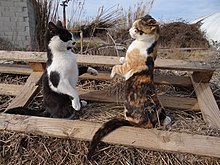Perhaps you feel you have a lonely cat who might benefit from having another cat companion. Before you select a new cat, remember that cats believe firmly in territory. Another animal on your present cat’s turf could cause the breakout of a war. You will need to know how to introduce cats to each other.
More often than not, at first meeting, the new cat and the old one will not become instant friends. So, what things should you do and not do when bringing home a newcomer? On the website, jacksongalaxy.com, you will find lots of good information on how to introduce cats.

Read these options: First, using these fundamental steps will allow you to have a head-start on the process.
1) Make sure you have established a routine feeding time with your old cat.
Do not free feed. If you set up scheduled meal-times, you have set the stage for the new cat and the old cat to share the experience of being fed around the same time for all meals in a day.
2) Establish a defined area for your new cat
If the cat can feel that this area belongs to him, he will feel less stressed by the newness of his situation.
Mingling his scent with human scents will help the cat establish a sense of home.
a) Use scent soakers, as cats are all about scent. These are soft items that absorb a cat’s scent. They can include such things as beds, blankets, carpets, cardboard scratchers, and scratching posts.
b) Don’t let them see each other at first. An important part of this technique prevents the cats from looking at each other. They know through scent, though, about the presence of the other cat.
c) Now swap sites. Once the new cat demonstrates a significant comfort level in his base camp, it’s time to let each cat explore the other’s territory. Still, they don’t see each other.
Not only will the cats explore each other’s space, but also they will leave their scent on many of the articles in the room. Taking on a shared scent gives the cats a chance for getting to know each other. Being based on the sense of smell, their shared scent offers an opportunity to communicate to each other.

Here’s a suggested process for swapping sites harmoniously:
1) Carry the newcomer out of his base camp, shut him into the bathroom
2) Allow the resident cat to walk into the newcomer’s base camp. Now shut the door.
3) Let the new cat explore the rest of the house.
4) Repeat this process a bit later or the next day. The new cat will let you know if he wants to move out of his secure spot and explore. That could take him anywhere from a few hours to a few days to feel this secure.
A feeding ritual from the other side of the door
The reason for this technique: It allows the creation of a positive association between the new cat and the resident feline. To follow this technique, place a bowl of food on either side of a closed door. Start with the bowls far enough apart so the cat can walk up, eat, and walk away with no incident. If close enough to the door, the cats will sense each other.
Gradually move the bowls closer.
Allow visual access
Now the two cats have become aware of the other’s scent. The time has now come for them to see each other. Start by placing the food bowls back where the two cats first started eating on opposite sides of the door.
At first, you need a “buffer barrier.” You could simply crack open the base camp door. However, a better option involves using a pet gate, higher than a baby gate, but with a walk-through door that you can use.
You can employ the “raise the curtain” technique. Drape a blanket over the gate, or use clothespins to hang it up. You can raise the curtain over time, allowing more visual access. This gradual approach makes many cats more comfortable when getting acquainted.
The Final Getting-Together
On this step, both cats get together in a room with no barrier. The worst thing you can do, though, is to bring both cats into a shared space without giving them something to do.
 In case conflict arises, you need a plan for countering this conflict. Often a fight starts with a chase, so control the space. Block off areas such as beds or couches and seal off open doors or passageways.
In case conflict arises, you need a plan for countering this conflict. Often a fight starts with a chase, so control the space. Block off areas such as beds or couches and seal off open doors or passageways.
Have a sight blocker ready. Use it to guide one cat out of the room. Cats can’t see through a sight blocker. It can be placed between them and they can’t bust through. It should be high enough so you don’t have to bend down to put it in place between the two.
If such an option doesn’t work, get your old friend, the blanket. Toss it over one of the cats, pick him up, and remove him from the room.
How does this “Eat, Play, Love” option work?
Your goal becomes bringing one cat into a room where another cat already participates in a high-value, fully engrossing activity. Your challenge becomes to keep both cats preoccupied for as long as possible with treats, positive reinforcement, play, and love.
You will find it very helpful if you have a partner to assist with this process. Here’s how you carry out this technique:
a) Start with one cat. Play with one cat in the room, and keep her moving, either with a toy or with treats
b) Bring in the other cat. Your partner can now bring in the other cat. Immediately engage with him either with a favorite food or a toy.
c) This technique works far better with a partner. Then you can both keep the play going and establish a rhythm. One of you keeps one cat busy and the other does likewise with the second cat.
d) End your session. Hopefully, this ending will be accomplished by the humans, and not the cats, but the session must end at some point.
Your final goal with “Eat, Play, Love.”
Once the cats can be comfortable with this togetherness technique, and you can end the session when you want, and not because the cats show signs of disagreement, your goal is more or less accomplished.
Break down the barrier between the cats for mealtime, and end your last session by feeding the cats together.
Watching a YouTube video may make the process easier to understand, so you can watch the one shown here:
Other YouTube videos on this subject can be found as well, so you may want to watch a couple of them.
The reference I used for this post is as follows:
jacksongalaxy.com/blog/the-dos-and-donts-of-introducing-cats

